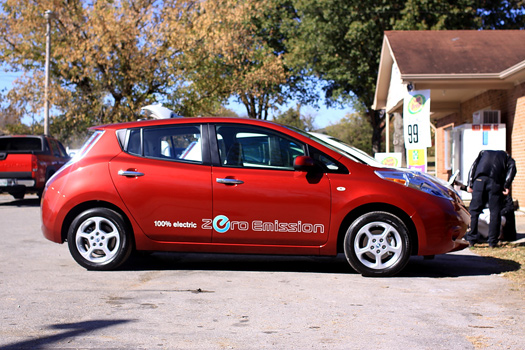

The Nissan Leaf is the first of its kind: a truly mass-market battery-electric car. Starting in December, Nissan will begin selling and leasing the car in North America, Europe and Japan. Globally, it will build 50,000 Leafs for the 2011 model year.
Check out the photo gallery
What’s New
A 600-pound, 24-kilowatt-hour lithium-ion battery pack, which lines the floor underneath the cabin, powers the Leaf for approximately 100 miles, a number that will grow or shrink depending on conditions and your driving style.
The Leaf draws a full charge in approximately eight hours from a 220-volt “Level II” charging dock; Nissan is leaning heavily on the Leaf’s first buyers to have a such a charger professionally installed in their garages, primarily because the company is aware of how profoundly annoying it will be to charge that big battery from a 110-volt outlet (it will take some 20 hours).
What’s Good
The Drive: A spin in the Leaf will rid anyone of the notion that electric cars are basically golf carts. Thanks to that greatest quirk of electric drive—instantaneous torque—the Leaf will quite literally push you back in your seat under hard acceleration. Things settle down from there; this is a compact commuter car, not a Tesla Roadster, and it feels faster than it is. Still, I found the Leaf perfectly solid and competent on the freeway. The 80-kilowatt AC synchronous easily pushed it to the brink of 90 mph, and the ride remained quiet, sturdy and smooth. I’ve heard of other drivers, presumably operating on more police-free stretches of road, reaching 94 mph, which is funny considering that the car’s top speed is officially limited to 90 mph. On some twisty country roads, the Leaf felt sharp, nimble, and fun. And around town, it drives like a smooth and whisper-quiet version of your standard nicely equipped compact car.
The Interior: The Leaf is surprisingly roomy for a little hatchback. Legroom in the driver and passenger seats was perfectly adequate. (I don’t know how I’d feel if I were taller than 6′ 6″), and Nissan says it has successfully mounted three car seats at the same time in the backseat. The cargo bay is remarkably deep.
The User Interface: The instruments and control panel are all suitably tech-tastic. A sharp-looking digital instrument cluster performs the usual functions (speedometer, odometer), tells you your remaining driving range, and gives you feedback on your energy usage, although the easiest way to figure out how efficiently you’re driving is to watch how quickly your remaining range drops. (By the way, push this car hard on the freeway, and that number will plummet.) In one mode, the bright, easily readable navigation screen displays the radius in which you can operate the car without running out of charge. Charging and interior climate can be controlled remotely via the Leaf’s smartphone app. And of course you’ll find the usual suite of mid-grade automotive gadgetry: Bluetooth, voice command, cruise control, an optional backup camera.
The Price: Lithium-ion batteries are expensive, and Nissan hasn’t released the price of the Leaf’s battery pack, but a reasonably informed guess pegs it somewhere between $15,000 and $20,000. Yet after the $7,500 federal tax credit, the Leaf starts at $25,280—cheap enough that no one understands how Nissan will make money on it. Lease rates are reasonable too: $2,000 down, $350 a month. And in states such as California and Colorado, which offer additional incentives (a $5,000 rebate and a $6,000 tax credit, respectively), the Leaf starts to become very attractive, particularly when you consider that you’ll never buy gas for the car, change the oil, replace the spark plugs, and so on.
What’s Bad
The Price: For people who don’t live in states with additional tax credits, $25,280 is a lot to spend for a compact car that can’t go farther than 100-something miles without stopping for a several-hour recharge—that is, for a second or third car.
For Many People, The Exterior Design: The car’s looks have grown on me—and it is certainly distinctive—but to others, the Leaf can look like a cartoon insect. Many of those design tweaks were made either to improve aerodynamics or reduce wind noise; for example, the bug eyes are there to deflect wind around the side-view mirrors, reducing noise at high speeds. But still.
The Verdict
The Leaf is a quick, nimble, fun-to-drive car that is, at least theoretically, more than adequate for the daily driving needs of 90 percent of Americans. Are you a dentist in Denver who bought a Land Rover for weekend ski trips, but now you’re tired of needlessly torching barrels of oil during your daily commute? The Leaf is a perfect workweek car for you. But when the weekend comes and it’s time to drive 300 miles in a stretch, the Leaf will not do, which is why you’ll be keeping the Land Rover in the garage.
None of the its limitations come from the engineering or design of the car itself (though you could argue that by opting to do a battery-electric vehicle instead of a plug-in hybrid, Nissan knowingly yoked it with its range limitations). In the coming years, as batteries get cheaper and more energy-dense, and as charging infrastructure spreads (right now, 13,000 Level II charging stations are planned for installation nationwide by 2012), cars like the Leaf will make more sense for a lot more people. And that’s not even considering what could happen to oil prices. At the moment, however, the Leaf must contend with the limitations that come with being the first and only mass-market battery-electric vehicle to arrive on the American market. We see it as the highly promising start of something very interesting.





